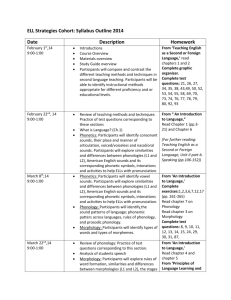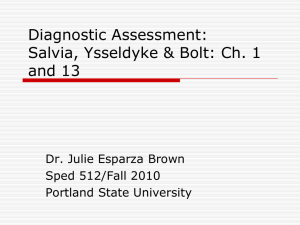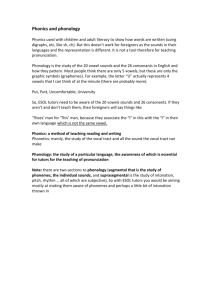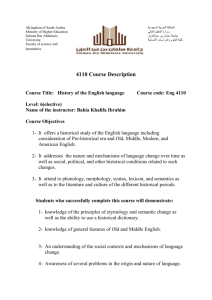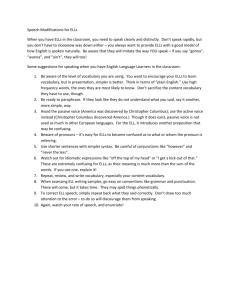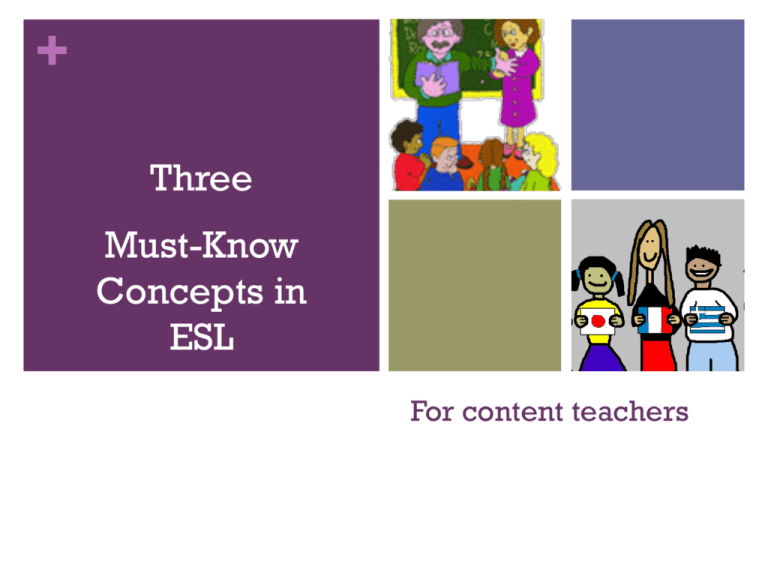
+
Three
Must-Know
Concepts in
ESL
For content teachers
+
First Concept: Linguistic
“I found the issues of morphology, phonology, and
syntax revealing and helpful. It is important to
understand how and why ELLs experience difficulties
with sound production, word formation, word order, and
understanding sentence patterns. When teachers realize
these things, they can select strategies and activities to
help make ELLs’ language acquisition successful.”
"I've seen the phonetic alphabet before, but didn't know
what each represented. This information helps me
explain to my students why certain letters sound different.
It was also helpful to see the explanation of why Spanishspeaking students pronounce words incorrectly.”
+
Phonology—Significant sounds in a
language
Phonology is the study of the significant sounds in a language.
Each language has its own phonology, and even though many
sounds may be shared among languages, some sounds may
exist in one language and not another. When this happens, the
speaker tends to substitute a sound in the native language that
approximates the sound in the second/foreign language.
Example: The English –th, as in father and thorough, does not
exist in many languages. The French speaker says, “My fazer
is very sorough in his work.” (My father is very thorough in his
work”).
+
Phonology
The rules of phonology also specify which sounds may occur in
word initial and word final positions.
Many Asian languages do not have as many consonant
clusters in word final positions as English does, making it
difficult for speakers to pronounce such words as asked / æskt/
or talked /tɔkt/.
English has 14 vowels, but Spanish has only 5. When
speaking English, Spanish speakers may substitute an existing
sound in Spanish for an English one, as in pronouncing
sick
/sIk/ as seek /sik/.
+
Morphology
Morphology is the study of word and word formation, including
affixes (prefixes and suffixes). Speakers will sometimes transfer
the word formation rules of their own language to English.
Example: Romance language speakers may prefer the more or
most forms for comparative and superlative adjectives when
English calls for –er or –est: Carlos was more big than his
brother.
Example: Speakers may overgeneralize the past tense forms of
verbs to irregular forms: Ella eated her lunch.
+
Syntax
Syntax refers to the rules that govern word order.
Syntax is specified in English. Students must learn
the order of words in basic statements and questions
as well as the specific order of noun phrases and
verb phrases in both affirmative and negative forms.
When there is a difference in the student’s native
language, there may be some interference.
Example: A French speaking student may say or
write, Mary has a dress red instead of Mary has a
red dress because color adjectives follow nouns in
the French noun phrase.
+
Second Concept: Error Correction
"I
learned about the different errors students
make (global and local). I now know not to
over correct or under correct errors. I know
to take into consideration the learner's
needs, level of language proficiency, and
personal reaction to error correction before
correcting."
+
Global Errors and Local Errors and
Mistakes
Global errors—incorrect forms that hinder communication
Example: “The different city is another on in the another two.”*
Local errors—a minor violation of the correct form but the hearer
or reader understands the message
Example: “Does John can sing?” (examples from Brown, p.
262)
Mistakes—a slip of the tongue, something not pervasive in the
ELLs’ speech
Example: “I like fruits and vegetables, maybe turpin greens.
Yes, turnip greens are very good.”
+
Where do errors come from?
Interlanguage transfer—the student refers to first
language knowledge when unfamiliar with the
second language
Example: the Spanish speaker may say “sheep”
instead of “ship.”
Intralanguage transfer: the student overgeneralizes
rules in the second language, for example, by
regularizing irregular verbs
Example: “I goed to the zoo.”
+
When to correct
Help students work through global errors by helping
them rewrite or restate their comments. Doing so
aids communication.
Decide whether correcting local errors is disruptive to
communication and impedes the student from
conversing. If not, then correct. If the focus is on the
message, do not correct.
Mistakes can be ignored if the student knows the
correct form and the mistake was a simple slip in
performance.
+
How to correct
Keep in mind that overcorrecting may result in the student
refusing to take risks in speaking and writing.
Types of Feedback
Recast
Expand utterance
Clarification request Ask student for clarification
Metalinguistic
feedback
Comment on the form of the
utterance
Elicitation
Prompt student to self-correct
Explicit correction
Provide the correct form
Repetition
Repeat the utterance with
corrections
Brown (277-78)
+
Important: Acquisition of some
forms is developmental
Students may go through the same developmental process of
acquiring some forms in English.
Example: The acquisition of negation goes through various
stages:
“I no like football.”
“I no can play football.”
“I do not can play football.”
“I cannot play football” or “I do not play football.”
+
Important: Acquisition is not linear
A teacher was overheard saying, “ I know
Juan can speak English better. I heard him
talking to his classmates, and he spoke
correctly. When I call on him, he pretends not
to know English and makes lots of mistakes.”
Students make progress and then sometimes
regress. Teachers should not interpret that
as defiance or lack of intelligence.
+
Third Concept—Legal Issues
"One
of the most important things that I
learned was about the legal issues
surrounding ESL. I've heard people at my
school express sentiments along the line of ‘I
don't understand why we have to teach
them, we know they're illegal and it shouldn't
be our responsibility.’"
+
Federal and State Laws on the
Education of ELLs*
Title
VI and VII of the Civil Rights Act of 1964
Office
of Civil Rights Memorandum (Standards for
Title VI Compliance) of May, 1970
Section
504 of the Rehabilitation Act, 1973
Requirements
based on the Supreme Court decision
in Lau v. Nichols, 1974
Equal
Education Opportunities act, 1974
+
Federal and State Laws on the
Education of ELLs continued
Requirement
of Vocational Education Guidelines,
1979
Requirements
based on the Supreme Court decision
in Plyler v. Doe, 1982
Americans
Florida
with Disabilities Act (PL 94-142)
Education Equity Act, 1984
+
Legislation: The Least You Should
Know
Federal Laws
Title VI, Civil Rights Act, 1964,-no person may be denied
rights and benefits of citizenship because of race, color, or
national origin
Lau V. Nichols, 1974, U.S. Supreme Court—a child must have
basic English skills to participate in the educational process and
may not be denied access to education because of limited
English.
Plyler v. Doe, 1982, U. S. Supreme Court—upheld Texas court
ruling that undocumented children have the same right to a free
public education as U.S. citizens and permanent residents.
No Child Left Behind Act of 2001—makes school districts
accountable for the education of all children, including ELLs.
+
References
Ariza, E., et al (2006). Why TESOL? Theories &
issues in the teaching English to speakers of other
languages in K-12 classrooms. Dubuque, IA:
Kendall/Hunt.
Brown. H. D. (2007). Principles of language learning
and teaching (5th ed.). White Plains, NY: Pearson
Longman.


